The Guess Worker
Networking
Overview:
-
The bridge I presented in the last post is flawed
-
In this post I will try to depict a fault-free bridge
If I'm going to make a bridge, I ought to know the rules of bridge building. But when it comes to bridges made of neurons, no-one knows the rules. So I'll have to invent them. Let's see if the bridge I make stands up.
Unconscious flaw
Two stimuli, separated in time, become associated using intermediary neurons which act as a bridge between the neurons of the stimuli. That, at least, is what I proposed in the last post.*1 There I used the following diagram to give a rough idea of how I thought the bridge was made:
 Fig.1
Fig.1
This diagram might be good enough to give a rough idea, but as an accurate description it fails. According to the diagram, once the bridge is fully formed all the pathways to the dopaminergic neurons are blocked off. Because impulses from these stimuli can't reach the dopaminergic neurons, the dog would no longer be able to hear the bell, or see the door, the flap and the food. The dog would become unconscious of its surroundings. Obviously dogs in real life don't become unconscious as they become conditioned. Somehow the diagram must be flawed.
The post goal
My goal in this post is to draw a more accurate diagram. How can I go about this? I have to think of a way of building the bridge without blocking off the dopaminergic pathways. What I could do is make a bypass: instead of putting the bridge on the pathways, I could place it beside the pathways.*2 I would need to make the bridge out of non-dopaminergic neurons so that pathways to the consciousness do not become blocked off.
The brain, though, is an extensive network of highly interconnected neurons and impulses could use many different pathways. Why would impulses be more likely to travel along this bridge than they would be to travel along any other pathway? The brain must have mechanisms to ensure that impulses travel in the desired direction.
Rules of construction
Here, boiled down to six rules, are my guesses as to what the mechanisms are:
- Bridges are built only by strengthening existing synapses (and not by making new linkages).
- When impulses from a single source enter a network of neurons, impulses radiate outwards in all possible directions.
- Whenever impulses cross a synapse, some of them are lost.
- How many impulses are lost depends on the strength of synapses: if the synapse is strong, most of the impulses will cross over to the next neuron; but if it is weak, few of them will get through.
- When two impulses arrive simultaneously at a pair of synapses leading to a single neuron, both synapses become stronger.
- The more impulses pass through a synapse, the stronger the synapse becomes.
Paring down the brain
Before I can use these rules to build my bridge, I still have to solve one more problem: the complexity of the brain.*3 A dog's brain has around 160 million crisscrossing neurons and to make an understandable diagram I'll have to simplify things.
I'll start by separating out the three types of neuron necessary for bridge building. These neurons are: 1) incoming sensory neurons, 2) dopaminergic neurons and 3) non-dopaminergic neurons. I'll put the incoming sensory neurons on the bottom half of a vertical plane and the dopaminergic neurons leading to consciousness on the top half of the same plane. Then I'll attach a network of non-dopaminergic neurons on a horizontal plane in between them.*4 The result is this: 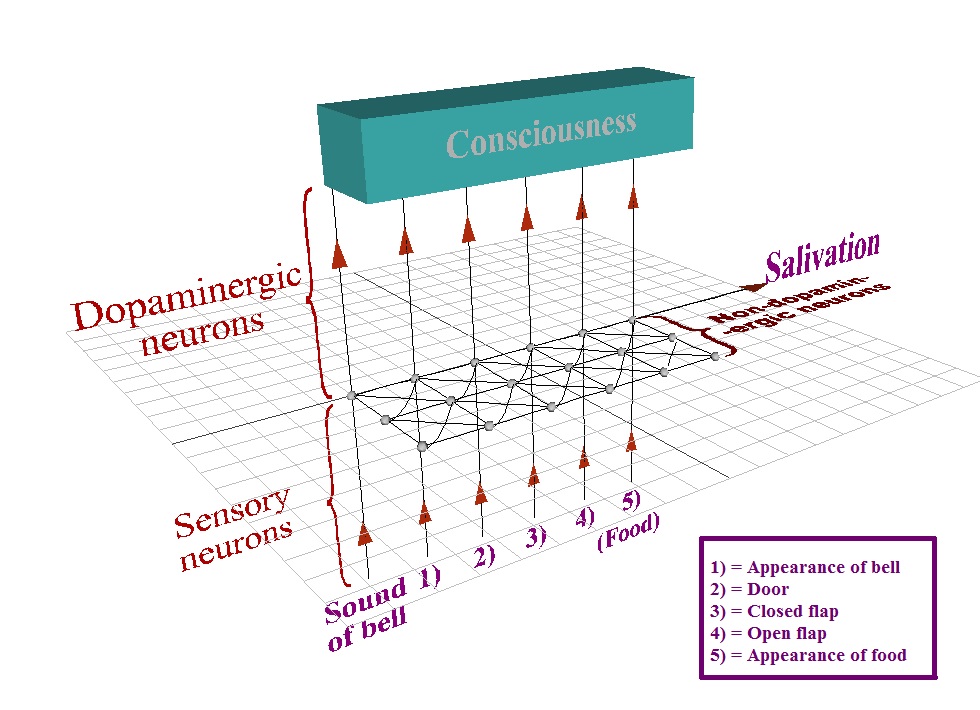
Fig.2
This diagram doesn't show any synapses nor all of the neurons but before I can add them I have to simplify some more. In a real brain each neuron can be connected to several thousand other neurons.*5 So I'll have to drastically reduce the number of connections. I'm only going to include connections between the closest neurons and on top of that I'm going to exclude connections carrying impulses in the reverse direction.*6
The full picture
Now I know what to include, I can add the remaining neurons and their synapses. The completed diagram looks like this: 
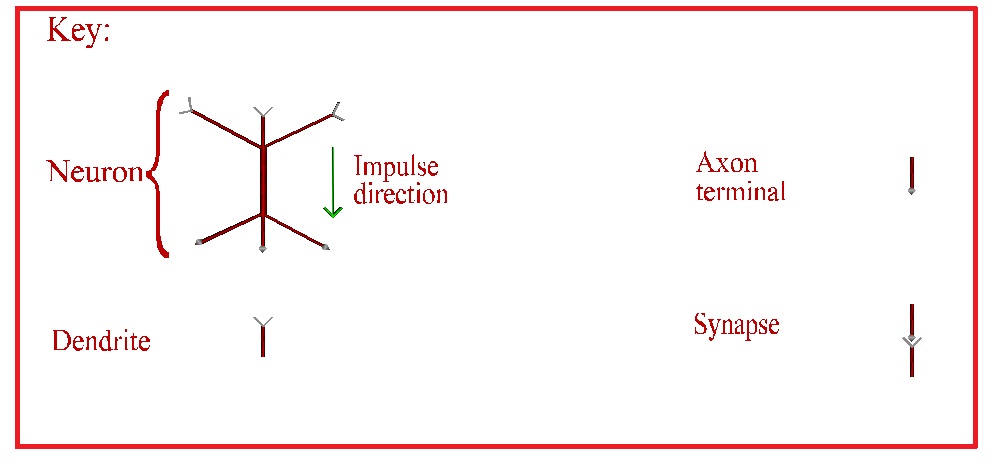
Fig.3
To make the above diagram more understandable, we should look at the image from two different angles. From the front we can see the dopaminergic and sensory neurons. (We can't see the network of non-dopaminergic neurons because its plane is on the same level as our eyes.):

Fig.4
And if we look from above, we can see the plane of non-dopaminergic neurons:
Fig.5
Following impulses
If we go closer to fig.3 we can see that impulses from the bell travel in four directions. (The impulse directions are shown in green.) Two sets of impulses go to dopaminergic neurons and two go into the network of non-dopaminergic neurons:

Fig. 6
To see what happens to the impulses going towards the dopaminergic neurons we'll look at the image from the front again:
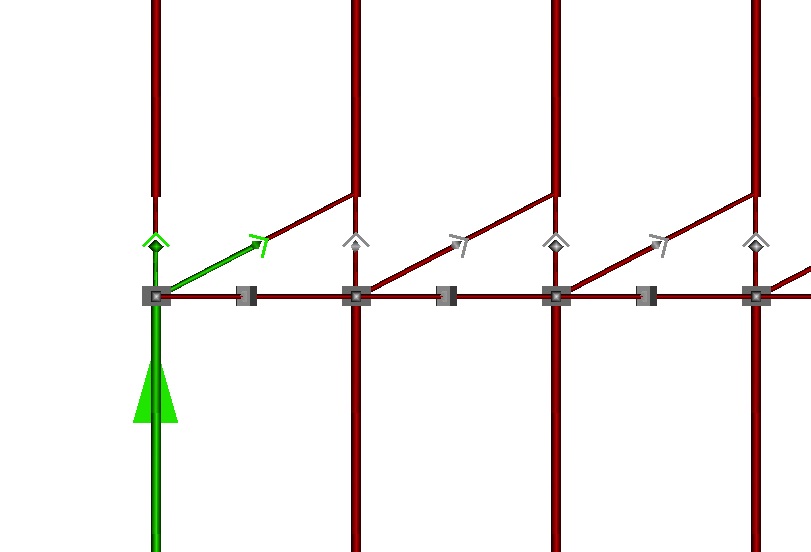
Fig.7
One set of impulses travels towards the dopaminergic neuron for the sound of the bell. When the dopaminergic neuron is activated, the dog consciously hears the bell. The second set of impulses travels towards the dopaminergic neuron of the second stimulus - the appearance of the bell.
When these impulses reach the dopaminergic neuron at the same time as impulses directly from the second stimulus, the synapses leading to the neuron are strengthened. The strengthened synapses are shown in yellow below:
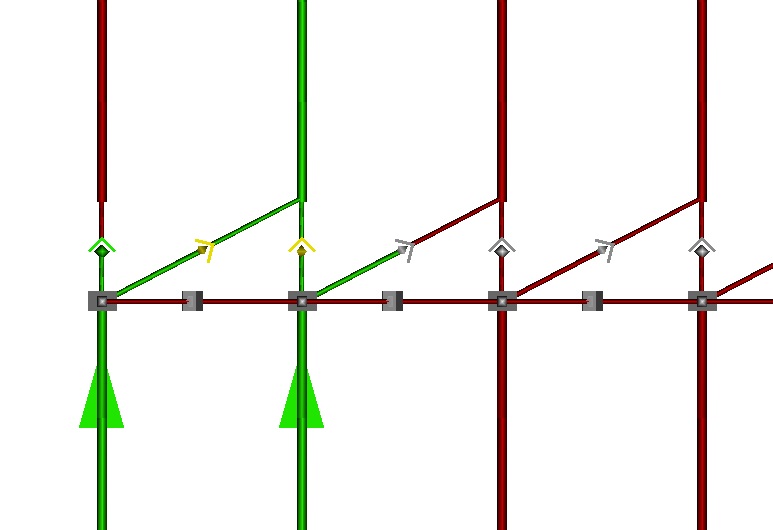
Fig.8
If the synapses above are strengthened enough, the sound of the bell becomes associated with the appearance of the bell.*7
Plane travel
Now let's examine the impulses which enter the network of non-dopaminergic neurons. Looking down on to the plane of non-dopaminergic neurons from above again, we can see one set of impulses travels diagonally across the plane. The other set moves along the plane in the direction away from the dopaminergic neurons: 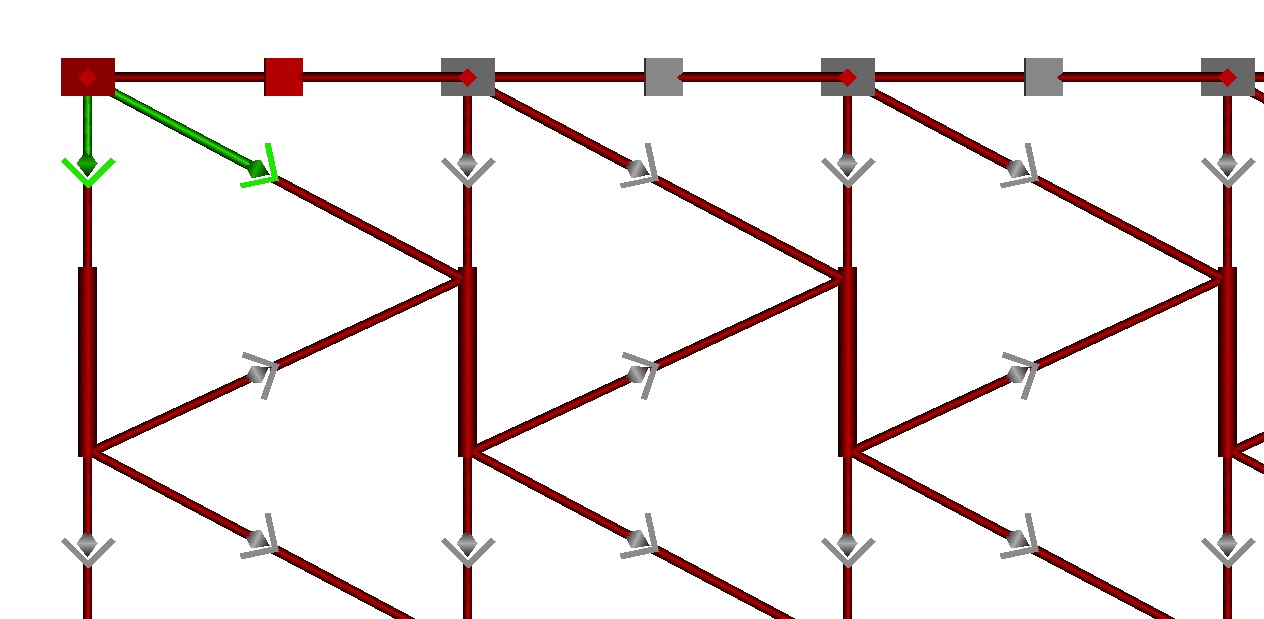
Fig.9
The impulses moving in the direction away from the dopaminergic neurons will eventually peter out as they encounter one synapse after another. But the fate of the impulses travelling diagonally is different. They come to a neuron which at the same time is receiving impulses from the second stimulus:
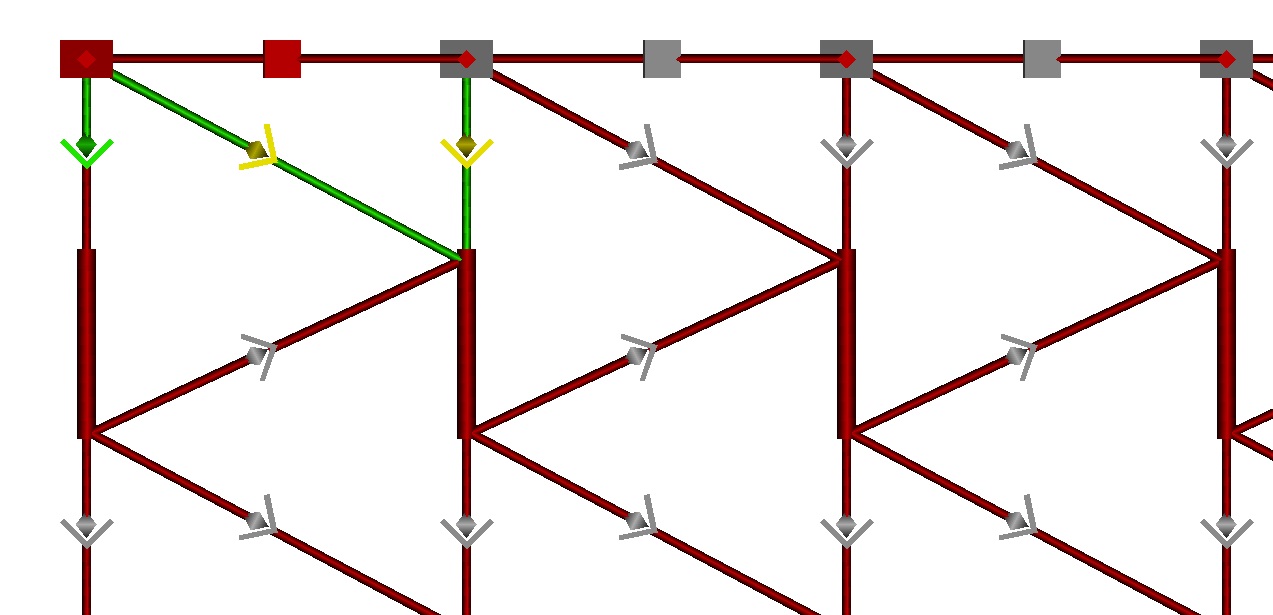
Fig.10
Because the neuron is receiving two sets of impulses simultaneously, its synapses are strengthened, and more impulses can move on to the next neuron. The same thing happens at the next neuron: the impulses arrive at the same time as impulses from the third stimulus, again the synapses are strengthened and more impulses can move on to the next neuron. The pattern continues along the chain of stimuli:
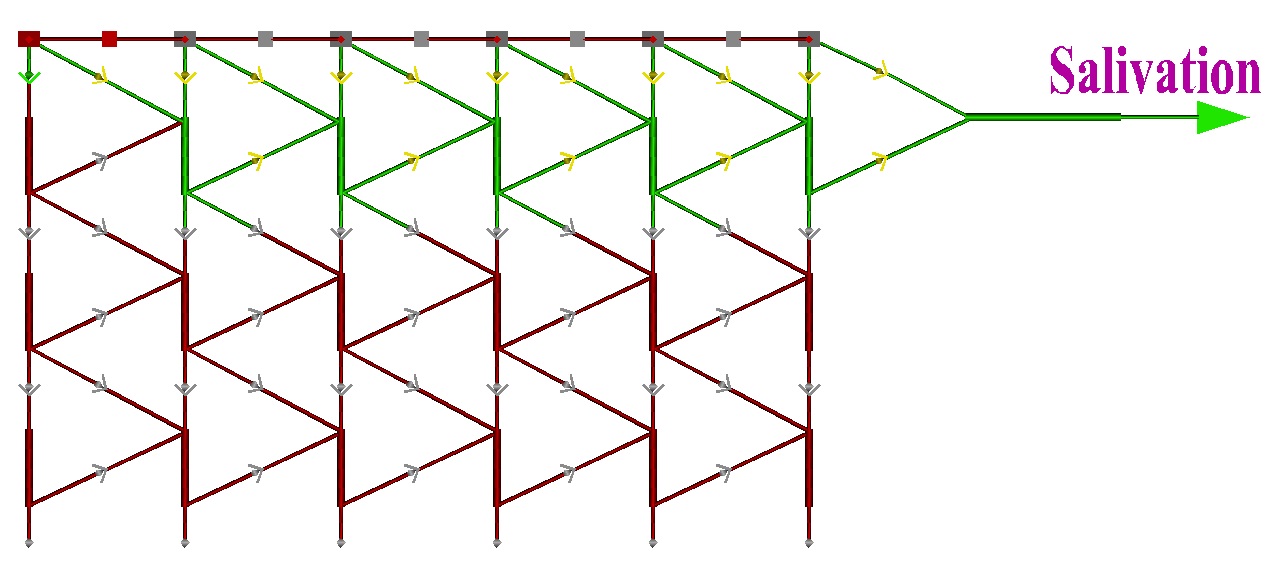
Fig.11
Impulses from the sound of the bell can now reach the motor neuron for salivation. With repetition of the stimuli, the synapses strengthen even more and the bridge emerges: 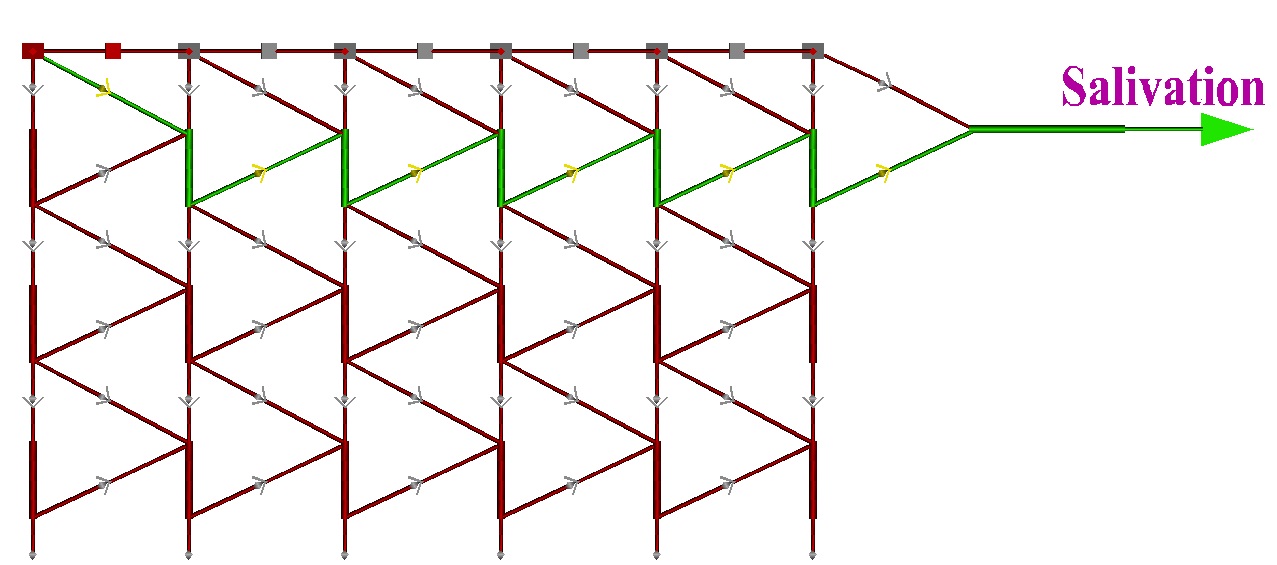
Fig.12
Which from the same angle as fig.3 looks like:

Fig.13
The impulses now have a fast route, bypassing consciousness, linking the sound of the bell to salivation. The dog has been fully conditioned.
Missing linkages
"Wait a minute!" I can almost hear you protesting. "Haven't you forgotten something? You've left out all the linkages from the stimuli along the chain."
You have a good point. If two sets of impulses arrive at the synapses of a neuron at the same time, both synapses should be strengthened. In that case, you would have thought, the bridge should look like this: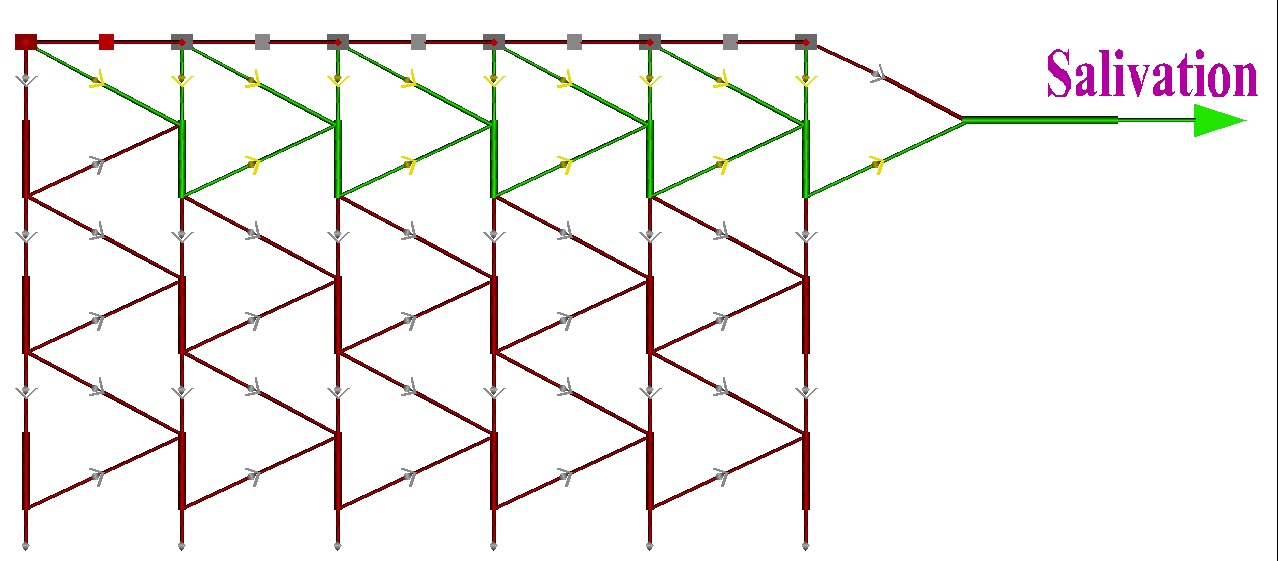
Fig.14
The bridge, though, wouldn't work if it looked like that. Impulses from any stimulus along the chain would be able to reach the motor neuron for salivation. The sight of the closed flap, for example, would make the dog salivate. Clearly, that is ridiculous.
Weak support
But how can I justify leaving out these linkages? Although the linkages do strengthen, I believe they remain relatively weak. Why? Because they are formed by stimuli which are not very salient. These stimuli only fleetingly attract the dog's attention and therefore generate relatively few impulses. If there are only a few impulses, then synapses are strengthened only slightly. *8 And seeing as the linkages are fairly weak, they break down quickly.
Shouldn't the same be true of the linkages on the bridge, then? Yes and no. At the beginning of the conditioning process, these linkages are indeed weak and would break down quickly if there were no repetition of the bell stimulus. The slight strengthening of the linkages, though, means that a few more impulses travel across the bridge than travel in other directions.*9 From now on, every time the bell is rung, impulses will be channelled towards the bridge. Because the sound of the bell is a salient stimulus, there will be many impulses crossing the bridge, and the structure will strengthen until it is stable.*10
Building greater understanding
Here we have a plausible mechanism for what happens in the brain during classical conditioning. Does it, though, help us understand anything else? First, it should lead us to a greater understanding of more complex, non-reflexive behaviour. Operant conditioning, in which complex behaviour is either strengthened through reward or weakened through punishment, has similar features to classical conditioning and so is likely, at least in part, to use the same mechanisms. We ought to be able to use the mechanisms of classical conditioning to help us understand those of operant conditioning. Then we'd be well on the way to understanding even the most complex human behaviour.
Second, the mechanism ought to give us clues as to how the human brain uses symbols. In bridge building, the neurons of different stimuli are linked together linearly. One neuron is connected to a second, and the second is connected to a third and so on. For symbolic thought, on the other hand, the neurons are arranged in layers: one neuron is linked to a second and both these neurons are linked to a third.*11 However, the neurons in bridge building also link up like this, even if only briefly and without any further building up of layers. The neuron for the sound of the bell, for example, becomes linked to the neuron for the appearance of the bell and then both neurons become briefly linked to the neuron activated by the sight of the door. So if we knew why similar temporary linkages become stronger in symbolic thought and then why these linked neurons build up into layers, perhaps we'd be able to solve the mystery of how the brain uses symbols.
It'll come as no surprise to learn, then, that I hope to explore complex behaviour and symbolic thought in more detail in future posts.
*1. See Time bridges.
*2. To improve on the analogy I used in the last post: instead of building a new express train line on the tracks of a local train route, I could lay the express line next to the local tracks. Then I could keep the old service running and avoid shutting down the small stations.
*3. Just as a civil engineer has to follow rules which reflect actual physical laws when building bridges, I will have to follow rules which I hope will reflect the actual mechanisms brains use.
*4. Although in the brain neurons are connected to each other from various directions, reducing them to two planes shouldn't remove anything essential because all three types of neurons can still connect to each other.
*5. I couldn't find any information on how many synapses on average a neuron in a dog's brain has. Perhaps the research has not yet been done. But just to give some perspective: the human brain's 100 billion (or so) neurons are connected by more than 100 trillion synapses. On average each neuron has around 7,000 linkages to other neurons.
*6. You might think that a more serious stumbling block is the row of sensory neurons - in a real brain we wouldn't expect to find these neurons next to each other in the order they are fired. However, what I have represented as a sequence in space should be thought of as a sequence in time: the first and second neurons fire together and therefore connect first, then the second and third fire together and connect...and so on.
*7. How conscious experiences like these become associated has been dealt with in more detail in Connections.
*8. The strengthening here occurs because of rules 5 and 6.
*9. We can think of the temporary linkages from the stimuli along the chain as being like the supports used for building real bridges. They are strong enough to hold up the initial structure, but as construction proceeds, the bridge becomes stronger than the supports. When the structure is ready, the supports can be taken away and the bridge will stand by itself.
*10. The strengthening here occurs because of rule 6.
*11. See The Concept.

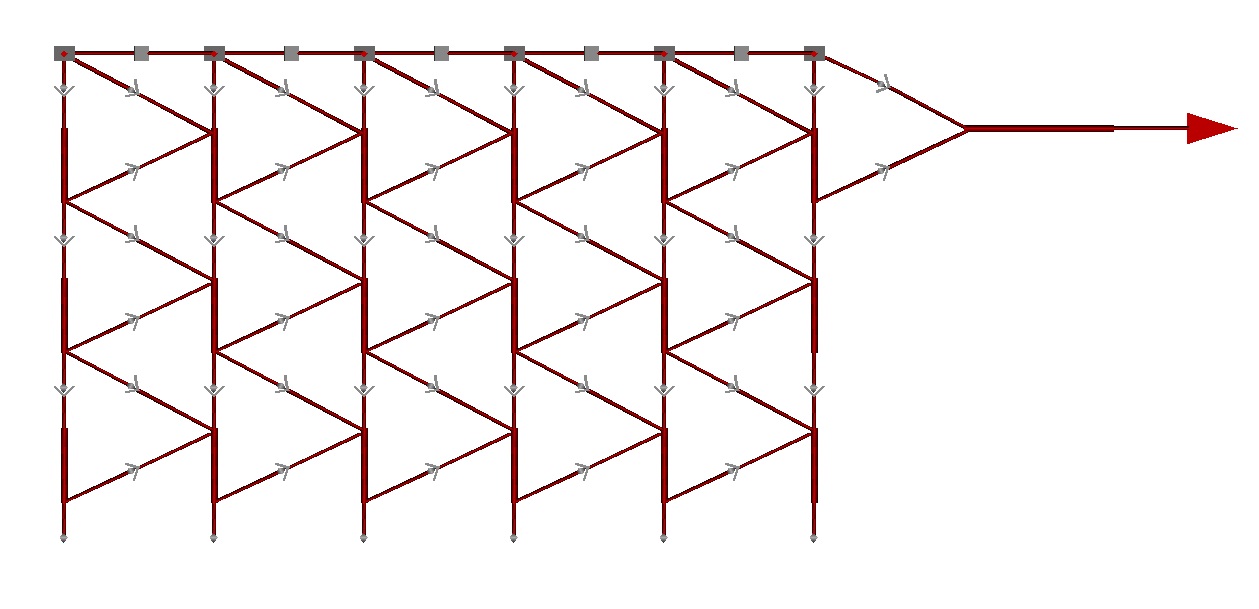
Comments powered by CComment